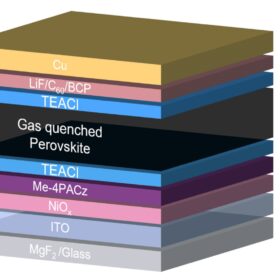Sekisui Chemical unveils plan to produce solar thin films based on perovskite
A spokesperson from the Japanese plastics maker told pv magazine that production is currently being carried out at a small facility in the laboratory, and that the location of a full-scale production facility is currently under consideration.
U.S. startup to produce perovskite glass for tandem modules
Caelux secured series A funding to deploy perovskite glass that can be integrated with existing solar manufacturing processes to boost module efficiency.
Imec presents inverted perovskite solar cell with 24.3% efficiency
The researchers of the Belgian research institute used a dual-layer treatment for the perovskite absorber, which they said improved the cell efficiency and stability. The device achieved an open-circuit voltage of 1.17 V, short-circuit density of 24.5 mA/cm2, and a fill factor of 84.6%.
NREL develops perovskite solar cells with 93% bifaciality
The National Renewable Energy Laboratory (NREL) has made highly bifacial perovskite cells with a front-side efficiency of 23%.
Fully printed carbon electrode perovskite solar cell achieves 19.2% efficiency
German scientists have fabricated a carbon electrode perovskite solar cell with a hole-transporting bilayer made of organic semiconductors instead of a conventional hole transport layer. They claim this approach improves the device’s fill factor and open-circuit voltage.
Commercial laser treatment to boost perovskite solar cell performance
European scientists used a nanosecond pulsed ultraviolet laser to reduce surface defects in perovskite films for solar cell applications. The result is a significant increase in cell efficiency and stability. The new technique may be particularly suitable for roll-to-roll (R2R) production lines.
GCL-SI unveils perovskite solar panel with 16.02% efficiency
GCL-SI has launched a new 320 W perovskite solar module. The company guarantees that the 10-year end power output will be at least 90% of the nominal output power, which decreases to 80% after 25 years.
Triple cation perovskite PV cell with ETL based on tin(IV) oxide hits 17.1% efficiency
Qatari researchers have incorporated an electron transport layer (ETL) made of tin(IV) oxide into a perovskite solar cell through air-thermal-annealing, resulting in better efficiency and stability. The device demonstrated an open-circuit voltage of 1.045 V, a short-circuit current of 22.01 mA/cm2, and a fill factor of 74.3%.
Perovskite solar cell based on indium sulfide ETL promises 20.15% efficiency
An international team has sought to use indium sulfide as an electron transport material in a perovskite solar cell. The result is a device with lower defect density and improved performance.
Longi claims 33.5% efficiency for perovskite/silicon tandem solar cell
The European Solar Test Installation (ESTI) has confirmed the results of Longi’s new perovskite/silicon tandem solar cell. It is currently the second-highest efficiency record in the world for a perovskite/silicon tandem cell.










